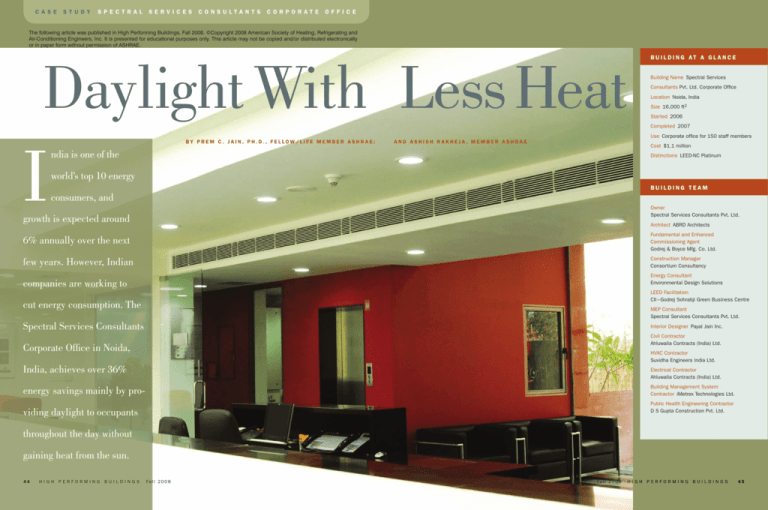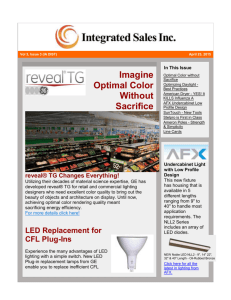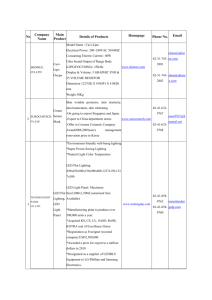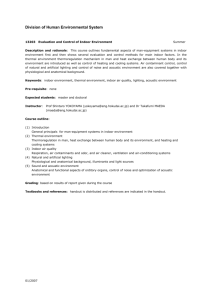Spectral Services Consultants Corporate Office: Noida, India
advertisement

c ase Stu dy Spectral Serv i c es C o n s u lta n ts C o r p o r ate O f f ice The following article was published in High Performing Buildings, Fall 2008. ©Copyright 2008 American Society of Heating, Refrigerating and Air-Conditioning Engineers, Inc. It is presented for educational purposes only. This article may not be copied and/or distributed electronically or in paper form without permission of ASHRAE. Daylight With Less Heat I B y P r e m C . J a i n , P h . D . , F e l l o w / L i f e M e m b e r A SHR A E ; a n d A s h i s h Ra k h e ja , M e m b e r A SHR A E ndia is one of the B u i l d i n g At a G l a n c e Building Name Spectral Services Consultants Pvt. Ltd. Corporate Office Location Noida, India Size 16,000 ft2 Started 2006 Completed 2007 Use Corporate office for 150 staff members Cost $1.1 million Distinctions LEED-NC Platinum world’s top 10 energy Building Team consumers, and Owner Spectral Services Consultants Pvt. Ltd. growth is expected around Architect ABRD Architects 6% annually over the next Fundamental and Enhanced Commissioning Agent Godrej & Boyce Mfg. Co. Ltd. few years. However, Indian Construction Manager Consortium Consultancy Energy Consultant Environmental Design Solutions companies are working to LEED Facilitation CII – Godrej Sohrabji Green Business Centre cut energy consumption. The MEP Consultant Spectral Services Consultants Pvt. Ltd. Spectral Services Consultants Interior Designer Payal Jain Inc. Civil Contractor Ahluwalia Contracts (India) Ltd. Corporate Office in Noida, HVAC Contractor Suvidha Engineers India Ltd. India, achieves over 36% Electrical Contractor Ahluwalia Contracts (India) Ltd. Building Management System Contractor iMetrex Technologies Ltd. energy savings mainly by pro- Public Health Engineering Contractor D S Gupta Construction Pvt. Ltd. viding daylight to occupants throughout the day without gaining heat from the sun. 44 High Performing B u i l d i n g s F a l l 2 0 0 8 F a l l 2 0 0 8 H i g h Performing Buildings 45 The payback period is expected to be less than four years. Building Envelope To accomplish the daylighting strategy, the building faces north-south, the optimal orientation for a building on the Indian subcontinent. Heavy glazing on the north and south façades brings natural light into the space. In addition, recessed windows with fins for shade cut down on direct solar heat gain on the west façade, which receives the most direct sunlight. The wall to window ratio, optimized at 22.5%, maintains a balance between heat ingress and daylight harnessing. Windows are hermetically sealed low-e double glass with a 0.33 shading coefficient and 60% visible light transmissivity. External walls are made of 8 in. thick autoclaved aerated concrete blocks, backed by 25 mm closed cell rubber insulation. This results in a U-value of 0.077 Btu/ h·ft2·°F. Roof surfaces are provided with 3 in. thick extruded polystyrene, covered partly with glazed white tiles and high solar reflectance paint (78 Noida, India The fresh air quantity is 30% higher than recommended by Standard 62.1-2004. 46 High Performing B u i l d i n g s F a l l 2 0 0 8 Noida is located towards the north of India and close to Delhi. The climate in the area has an average temperature of 110oF in the summer, 95oF during monsoon season and 45oF in the winter. In a year, 90% of days are bright and sunny. Advertisement formerly in this space. solar reflectance index). The resulting U-value is 0.063 Btu/h·ft2·°F. Harnessing Sunlight Despite the hot and humid climate, the 16,000 ft2, five-floor office building provides daylight at a 250 – 350 lux level throughout the day without gaining heat from the sun. More than 75% of the building’s interior is daylit, and 90% of occupants enjoy outside views. The building site and most parts of northern India receive more than 300 days of bright sunshine annually. On most working days, the sun provides sufficient light so that electric lighting is switched off during operation hours. A large atrium extends over all floors of the building. A south- inclined (15 degrees to horizontal) skylight encompasses the entire atrium. Because the sun moves southward for the majority of the day, the skylight, also called the light catcher, plays an important role in daylight harnessing. To minimize heat from direct sunlight, the light catcher has permanently inclined louvers of dull aluminum metal. By blocking direct sunlight throughout the day, the louvers reduce airconditioning loads and glare on workstation computers. The louvers’ angle was computer simulated to study year-round performance. Night Lighting In the evening, an advanced lighting management system automati- HPB.hotims.com/21087-15 48 High Performing B u i l d i n g s F a l l 2 0 0 8 Advertisement formerly in this space. Recessed windows with fins cut down on direct solar heat gain. Da y l i g h t P e r f o r m a n c e diverted to authorized disposal agencies. To reuse resources, furniture from Spectral’s old offices was remodeled and used in the building. A small amount of Forest Steward Council certified wood was used for the executive floor furniture. Lastly, 2.5% of the building material, like bamboo flooring, is from rapidly renewable resources, and 7.7% is reused or salvaged material. A model was used to estimate daylight performance. The illumination for the space was calculated using the clear sky conditions at noon on the equinox (March 21). indoor temperature and relative humidity between 23°C and 25°C and 40% to 60% respectively. In addition, all air-handling units can execute a complete air-side economizer cycle for free cooling of the indoors during fair weather. A south-inclined skylight encompasses the entire atrium and harnesses daylight. Fire Safety Even though the constructed area of the building is small, it provides a fire-safe environment to occupants. An intelligent, addressable fire alarm system and water-based fire fighting system ensure a high level of fire safety, exceeding the norms of India’s national building code. Reusing Materials cally switches on internal lighting. The system ensures a constant lux level using dimmable ballasts on each lighting fixture. Occupancy sensors control lighting in regularly unoccupied areas like toilets and meeting rooms. The average internal lighting power density is 0.63 W/ft2, approximately half the IESNA recommended lighting power density of 1 W/ft2 for offices. Indoor Air Quality A high level of indoor air quality is maintained by monitoring indoor CO2 levels and controlling the fresh air quantity injected into the space by modulating fresh air dampers. The fresh air quantity is 30% higher than 50 High Performing recommended by ANSI/ASHRAE Standard 62.1-2004, Ventilation for Acceptable Indoor Air Quality. Recovering energy from the bathroom and atrium exhausts precools the fresh air. Electrostatic precipitators with MERV 13 efficiency combined with prefilters with MERV 6 efficiency on all air-handling units ensure a dust-free indoor environment. The air-conditioning system, besides providing a dust-free environment to occupants, closely controls indoor temperature and relative humidity levels. Each airhandling unit in the building is provided with an ultrasonic humidifier and electrical heater installed within the supply air duct. The B u i l d i n g s F a l l 2 0 0 8 During construction, 96.6% of the building waste was collected and Below Permanently inclined louvers block direct sunlight and reduce air-conditioning loads. More than 75% of the building’s interior is daylit. building’s management system runs the entire operation, maintaining F a l l 2 0 0 8 H i g h Energy Use With energy-efficient features, such as north-south building orientation, insulated envelope, low-e double glass and reduced lighting needs, the peak air-conditioning load for the building is 50 tons of refrigeration. This is approximately half the load of a similar office in New Delhi, India. The average year-round load for the Spectral Office hovers around 35 – 40 tons of refrigeration. The installed air-conditioning plant consists of 72 tons of refrigeration, high COP water-cooled screw chilling machine with twin compressors, variable speed chilled water pumping system, cooling tower with variable frequency drive, air-handling units on all floors coupled to variable frequency drive, and internal air distribution through variable air volume boxes. The baseline yearly electrical energy demand for the building, per ANSI/ASHRAE/IESNA Standard 90.12004, Energy Standard for Buildings Except Low-Rise Residential Buildings, is 394,196 kWh (25 kWh/ft2 per year) and the predicted actual annual energy demand for the building is 242,086 kWh (15 kWh/ ft2 per year). The building achieves 38.6% electrical energy savings over the Standard 90.1 base building. Actual performance is even better, as seen in the energy table. The average monthly energy bill is $2,500. This is less than half of the bill at Spectral’s previous offices, which were well-designed conventional buildings. Performance Data Modeled Actual Energy Use Energy Use Month in kWh in kWh September 2007 22,510 17,492 October 2007 20,252 14,243 November 2007 17,460 10,399 December 2007 17,392 8,386 January 2008 17,544 4,490 February 2008 15,345 15,501 March 2008 18,509 16,724 April 2008 19,715 21,332 May 2008 22,751 20,473 Table readings were obtained from the building management system and compiled by an independent third-party commissioning agent. Performing Buildings 51 Building Management System Z e r o Wa t e r D i s c h a r g e The Spectral Office is a zero water discharge building with 100% rainwater harvesting where rainwater is discharged through wells into underlying aquifers. An in-house 10,000 L sewage treatment plant has been installed for waste and soil. Because there are no municipal sewage mains in the area, the plant is essential and helps in recovering the treated water for gardening, air-conditioning cooling towers makeup and flushing. Municipal water intake is 6500 L per day. The sum of gray and black water generated in the building is 5554 L per day, which is sent to the plant. The treated water from the plant is apportioned 4700 L per day for cooling tower makeup, 1620 L per day for flushing and 854 L per day for gardening. The solids will be pumped out of the plant annually and used as manure. Municipal Water Supply 6500 L per day Storage Tank The services systems operations are coordinated through a Webbased advanced building management system. Only two operation staff members are employed to handle day to day tasks. The operation parameters can be accessed from any of the 150 workstations in the building and provide feedback to occupants. The feedback has been useful in upgrading the HVAC system for winter heating. At ambient temperatures below 24°C (75°F), the building operated in free-cooling mode with a 100% open fresh air and exhaust air damper at all air-handling units. These have been corrected for the winter heating mode operation by energizing the heating coils at ambient temperatures below 20°C. Payback Domestic Use Miscellaneous Utilities 6060 L per day 340 L per day 100 L per day Sewage Treatment Plant 7174 L per day Toilet Flushing Landscaping 1620 L per day 854 L per day Soft Water to Air-Conditioning Makeup Cooling Towers 4700 L per day 52 High Performing B u i l d i n g s F a l l 2 0 0 8 Prior to construction of the building, analysis of the total construction cost was carried out to determine the anticipated additional impact due to incorporation of energy-efficient measures such as the high-efficiency chiller, energy conservation strategies for airhandling units, lighting controls, low-e double glass, wall insulation and the sewage treatment plant. The cost of the green building was $1.1 million, approximately 8% above a similar conventional building. The energy simulation predicted a payback period of less than four years. With rising energy costs and anticipated greater energy savings than predicted, the payback period may be reduced to three years. Advertisement formerly in this space. Lessons Learned Overcoming Climate Careful building orientation, optimum window sizing, lowe double glass and envelope insulation demonstrate that, even in the hot and dry climate of northern India, careful design can minimize heat ingress. Design Discipline It is surprisingly easy to save large amounts of energy and water by imposing discipline on the whole design and build team and by holding regular design coordination meetings with a clear mandate on achieving targets. The design team met regularly to discuss the challenges posed in sustainable construction which spawned new ideas and ensured better coordination of the design elements. For example, ideas for extensive use of waste, such as broken china mosaic tiles on the roof and construction debris as the sub-base for the flooring, originated from these meetings. Occupant Feedback Employees enjoy the building’s indoor air quality and daylight. Although the building is closely connected to the community with residential and commercial areas near one another, individuals often choose to stay in the building during their lunch break. When compared to previous office situations, employee absenteeism has dropped, and productivity has increased. The building takes advantage of more than 300 days of bright sunshine annually in Noida, India. Although India is one of the world’s top 10 energy consumers, the country is taking measures to increase energy efficiency. According to The Times of India, industry professionals expect the number of green building projects in India to increase from the current 164 to more than 2,000 by 2012. As a role model for future developments, the Spectral 54 High Performing Office contributes to this growing sustainable trend. • The air-conditioning load is half that of a similar office building in the area. B u i l d i n g s F a l l 2 0 0 8 Finding Local Sources Obtaining sustainable building materials from local sources was problematic. The building team had to hunt for vendors for bamboo flooring, low VOC paints, low flow fixtures and material made of recycled components. About the Authors Prem C. Jain, Ph.D., is chair of the Indian Green Building Council and chair and managing director of Spectral Services Consultants in Noida, India. Ashish Rakheja is cochair of the Indian Green Building Council’s technical committee and chief operating officer for Spectral Services Consultants. Advertisement formerly in this space.




